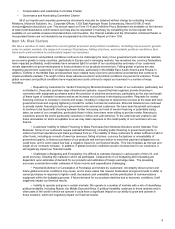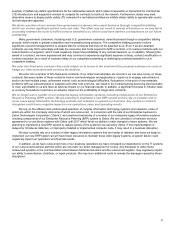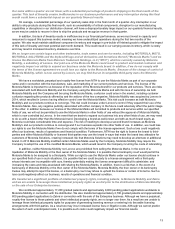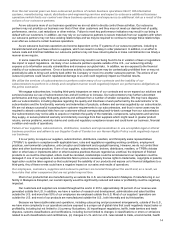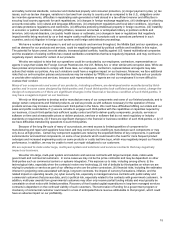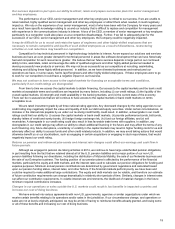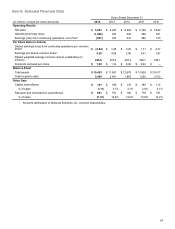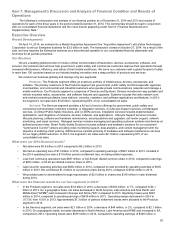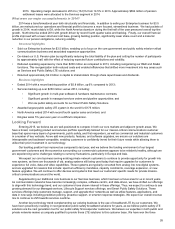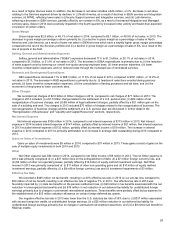Motorola 2014 Annual Report Download - page 21
Download and view the complete annual report
Please find page 21 of the 2014 Motorola annual report below. You can navigate through the pages in the report by either clicking on the pages listed below, or by using the keyword search tool below to find specific information within the annual report.19
Our success depends in part upon our ability to attract, retain and prepare succession plans for senior management
and key employees.
The performance of our CEO, senior management and other key employees is critical to our success. If we are unable to
retain talented, highly qualified senior management and other key employees or attract them when needed, it could negatively
impact us. We rely on the experience of our senior management, most of who have been with the Company for many years and
as a result have specific knowledge relating to us and our industry that is difficult to replace and competition for management
with experience in the communications industry is intense. A loss of the CEO, a member of senior management or key employee
particularly to a competitor could also place us at a competitive disadvantage. Further, if we fail to adequately plan for the
succession of our CEO, senior management and other key employees, the Company could be negatively impacted.
It may be difficult for us to recruit and retain the types of engineers and other highly-skilled employees that are
necessary to remain competitive and layoffs of such skilled employees as a result of divestitures, restructuring
activities or cost reductions may benefit our competitors.
Competition for key technical personnel in high-technology industries is intense. As we expand our solutions and services
business we have an even greater demand for technical personnel in areas like software development than we have historically
had and competition for such resources is greater. We believe that our future success depends in large part on our continued
ability to hire, assimilate, retain and leverage the skills of qualified engineers and other highly-skilled personnel needed to
develop successful new products or services. We may not be as successful as our competitors at recruiting, assimilating,
retaining and utilizing these highly-skilled personnel. In addition, as we have divested businesses and restructured our
operations we have, in some cases, had to layoff engineers and other highly skilled employees. If these employees were to go
to work for our competitors it could have a negative impact on our business.
We may not continue to have access to the capital markets for financing on acceptable terms and conditions,
particularly if our credit ratings are downgraded.
From time to time we access the capital markets to obtain financing. Our access to the capital markets and the bank credit
markets at acceptable terms and conditions are impacted by many factors, including: (i) our credit ratings, (ii) the liquidity of the
overall capital markets, (iii) strength and credit availability in the banking markets, and (iv) the current state of the economy.
There can be no assurances that we will continue to have access to the capital markets or bank credit markets on terms
acceptable to us.
We are rated investment grade by all three national rating agencies. Any downward changes by the rating agencies to our
credit rating may negatively impact the value and liquidity of both our debt and equity securities. Under certain circumstances, an
increase in the interest rate payable by us under our revolving credit facility could result. In addition, a downgrade in our credit
ratings could limit our ability to: (i) access the capital markets or bank credit markets, (ii) provide performance bonds, bid bonds,
standby letters of credit and surety bonds, (iii) hedge foreign exchange risk, (iv) fund our foreign affiliates, and (v) sell
receivables. A downgrade in our credit rating could also result in less favorable trade terms with suppliers. In addition, any
downgrades in our credit ratings may affect our ability to obtain additional financing in the future and may affect the terms of any
such financing. Any future disruptions, uncertainty or volatility in the capital markets may result in higher funding costs for us and
adversely affect our ability to access funds and other credit related products. In addition, we may avoid taking actions that would
otherwise benefit us or our stockholders, such as engaging in certain acquisitions or engaging in stock repurchases, that would
negatively impact our credit rating.
Returns on pension and retirement plan assets and interest rate changes could affect our earnings and cash flow in
future periods.
Although we engaged in pension de-risking activities in 2014, we continue to have large underfunded pension obligations,
in part resulting from the fact that we retained almost all of the U.S. pension liabilities and a major portion of our non-U.S.
pension liabilities following our divestitures, including the distribution of Motorola Mobility, the sale of our Networks business and
the sale of our Enterprise business. The funding position of our pension plans is affected by the performance of the financial
markets, particularly the equity and debt markets, and the interest rates used to calculate our pension obligations for funding and
expense purposes. Minimum annual pension contributions are determined by government regulations and calculated based
upon our pension funding status, interest rates, and other factors. If the financial markets perform poorly, we have been and
could be required to make additional large contributions. The equity and debt markets can be volatile, and therefore our estimate
of future contribution requirements can change dramatically in relatively short periods of time. Similarly, changes in interest rates
can affect our contribution requirements. In volatile interest rate environments, the likelihood of material changes in the future
minimum required contributions increases.
Changes in our operations or sales outside the U.S. markets could result in lost benefits in impacted countries and
increase our cost of doing business.
We have entered into various agreements with non-U.S. governments, agencies or similar organizations under which we
receive certain benefits relating to its operations and/or sales in the jurisdiction. If our circumstances change, and operations or
sales are not at levels originally anticipated, we may be at risk of having to reimburse benefits already granted, and losing some
or all of these benefits and increasing our cost of doing business.


